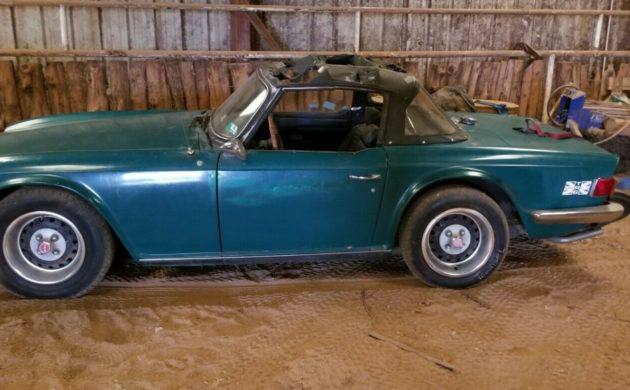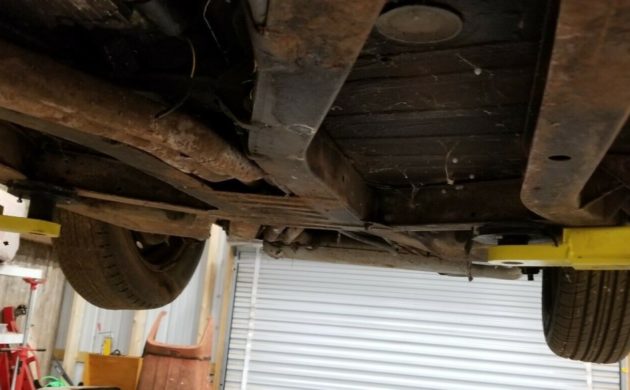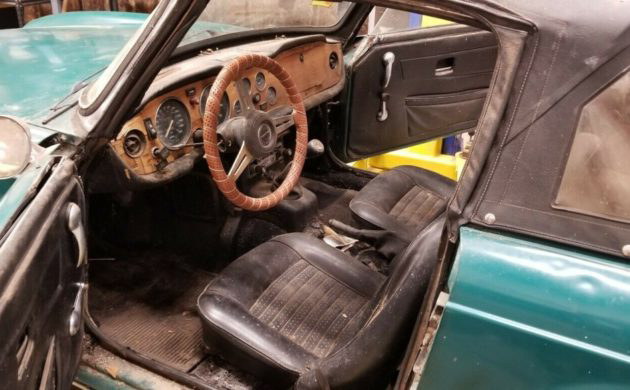When a no-reserve, inexpensive Triumph TR6 comes up I’m always paying attention. This 1974 model is listed for sale here on eBay and is going pretty cheap at the moment for just over $3,000 without a reserve. It’s waiting for you in Edmond, Oklahoma.
We’ve gone into detail about the positives and negatives about TR6s in the past. Basically, it’s a raucous car (or at least feels like it is) that rides rough but is tough. Weaknesses include inadequate thrust washers (see if the crankshaft clunks back and forth) and differential and semi-trailing arm mounts that tend to become damaged through breakage and/or rust. Of course, like almost any British car of this era, there are leaks and potential electrical issues to sort out. However, the driving experience and exhaust note are some of the best around. This one looks like it’s had a non-sympathetic storage period with a shredded top and minor dents all over. I don’t see a lot of rust, though.
The seller was kind enough to put the car on a lift and take a lot of pictures. That’s both a factory shop manual and an owners’ handbook sitting on the hood. The black strip angled near the driver’s side headlight is just a piece of misplaced weatherstripping; nothing to worry about.
You can see (kinda) the front side of the semi-trailing arm mounts from here. I’d want to see a close-up shot; those are box sections that rust horribly. It’s hard, but not impossible, to tell if the differential mounts have cracks. You know it as soon as you accelerate/decelerate but that won’t help with this car as it’s not a runner at the moment. The seller tells us the car was originally stored due to a slave cylinder issue. I’ll be honest, while that could easily be true, I’ve seen folks before doing everything they can to get more movement out of a TR6 slave cylinder when the problem was really worn thrust washers preventing the clutch from disengaging (the crankshaft/flywheel move forward rather than allowing the clutch do its job).
One very important thing to note about this picture is the second stalk on the left-hand side of the steering column. That means this is an overdrive-equipped car, a very desirable option (assuming the original transmission is still in place). A 1974 should have a J-Type overdrive. You can also see some more of the dents and dings right below the top.
One surprising thing about this shot is that the engine still has what looks like its original green plug wires and some of the original green radiator hoses. Although the battery platform has some surface rust, it’s far better than some I’ve seen. This should make someone a great rolling restoration project; does it appeal to you?








If ever there was a car that needed a restmod…this would be it.
Keep the exterior look…but lose the hideous safety bumpers. Shoehorn a modern paddle shifter 300-350hp V-6 drivetrain down in there. ( maybe BMW?) Stitched leather seats and dash.(yellow & gray patterned) Stealth gray paint or wrap on the body. Yellow & gray wheels.
These were always a car i wanted – however this one, like many others need alot of work- at my age id like the one that is ready to drive and go-and made ready with someone else’s thousands – so many cars, so little time
Detroit land yacht, my thoughts were the same as yours while looking at this TR6. Keep the body and discard the drive train . The new Toyota Supra drivetrain would make quite the interesting and fun TR6. Wouldn’t it be nice to just drive a TR6 and never have to worry about fixing it on your days off.
Arghh please stop it with the engine changes.
The TR6 with 300hp would be disastrous unless you have someone with the skills of Phil Remington, Pete Brock and a really good electrical engineer to build it for you. First off the suspension is not going to take it you are going to need a complete redesign, the rear cambers to much and putting all that power through it will just make it worse also the diff and mounting points are going to have to be replaced. For the front because you are putting more load on it you will need to replace the front spindles, also all the chassis pick up points will need to be reinforced. Want to put a modern engine with paddle shifters, well how are you with a CAN BUS system, can you fabricate a custom fuel tank to fit. What are you going to do for chassis twist. And I could continue but it just goes on and on of items needing upgrades.
If your goal is to go fast just buy a Miata, and then go do some HPDE events and learn to go fast.
The TR6 is a neat little car and it does have some shortcomings that can be fixed. It was originally designed to have about 150 bhp and it can handle about 170 to 200. All this can be done with the original engine. Put an electronic distributor in it, a painless wiring system and beef up the diff mounts and you have a pretty reliable car that would be fun on the road and the track.
Then take it to your local track, and I am not talking drag or circle this is a sports car you want a road course. Then start working on your driving. At VIR my local track you should be able to run a 2 min lap on the north course, but will probably start closer to 2min 20 secs, work on to get the times down. Once you get down to 1 min and 50 and want to go faster. Get a different car.
I go to car shows about once a year, and it is not unusual to see a car like this with some type of big engine in it and a fat guy in a lawn chair behind it who is only to glad to tell you how fast it is. When I ask about his lap times, I always get a blank stare. The car is nothing more than a bauble to live out his bench racing dreams.
If you want to see how hard it is to drop an engine in a car that wasn’t designed for go to a chumps or Lemons race. There are usually several cars like this, that run and while there may have been one I can’t think of a single one that ended up in the winners circle. Most end up broken, or not working nearly as well as expected. The few that do well have been majorly re-engineered and are darn near tube frame cars. Heck even Jamie who use to run a semi reliable Marina has run a TR6 with a ford V6 and so far it has not really set the track on fire.
If you want a big engine in a small car just go buy a Kit car. Factory Five sells a well engineered cobra that can be completed for about 37k. Stalkers sells a v6 super 7, and there are several others, but get one of these and don’t be the fat guy.
Kevin, I agree with everything you said apart from that I haven’t run (or built) a TR6 w/V6 yet. Thinking about it, yes!!! :-)
There is nothing wrong with old British engines and mechanicals. They require different maintenance – very akin to pre -1960’s American cars. For one they rely on “oil drip” to keep everything wet and lubricated – so does my father – in law’s 56 Ford. After replacing the fuel, lines, spark plug wires and plugs my British car came to life accidentally – I was just trying to see if the mechanical fuel pump was working…. British cars relied on light weight with modest power to produce (relatively) inexpensive driving fun. They are from the era of owner maintenance and owner tuning. That is part of the enjoyment of owning one – YOU get a sense of pride knowing that YOU are the reason that it’s running like a top.
Dropping an engine that wasn’t designed for it, was exactly what British sports cars were always about. That’s why they had things like, canister oil filters, directly over frame rails. But an old 4 litre 200 hp Jeep straight six, might fit nicely, and keep a lot of character. I had a TR 250, several years, and loved it. Art
Thank you for saying what needed to be said. However, I will take some exceptions. It is not that hard to swap engines, but to do it really nice takes skill & time (money helps). I know, I have done my share professionally. Once in Texas I saw a Spitfire cruise by that really caught my eye, but then he rev’d it up and it sounded like a Honda S2000.. I love both cars, but not Frankenstein’d together! I had a TR4 and it sounded like a TR4. I have an ’82 RX7 and it sounds like an RX7. And I am tired of everyone who’s first comment is “you should put an LS in it.”
As a long-time aficionado of European sport cars, the Triumph marque is perhaps my favorite. Sure, they’re not the fastest 0-60 mph–if wants that, get a Cobra. Sure, it’s not the best handling–if one wants that, buy a Lotus Europa. Sure, it’s not the most attractive–if one wants beauty, buy Italian. It surely is not the most reliable–if one desires reliability, buy a Miata. And finally, Triumphs are not the best quality–buy an old German car–not the new over-complicated garbage.
The Triumph cars offer what I consider the right balance. They are very easy to maintain, very simple by today’s standards, and provide the owner with many smiles per mile. Be prepared to do your own maintenance unless you have a REPUTABLE mechanic and deep pockets. Join your local Triumph club and communicate with folks at the Triumph Experience on line. You will find so many like-minded individuals who are willing to help you sort out any issues you will (notice I said will and not “might”) encounter.
Finally, regarding engine swaps…not my cup of tea. The factory engineers spent countless hours trying to wring out the most horsepower when these cars were being designed. So many of us think we can extract a few more ponies, and while we can do so, it comes at the expense of reliability and handling. Enjoy the Six for what it is…a quintessential British roadster!
This Tr6 is actually a ’74-1/2. ’74’s had solid color turn signals
that were above the bumper. ’75’s had solid turn signals below the bumper.
All ’74’s didn’t have an air pump either.From what I observed,all ’74’s
built up to ’75 didn’t have them.
I had a ’74 -1/2,& I agree,the stock engine had enough power,plus
that nice 6 cylinder sound.
Nice cars,,,when new, better have deep pockets for these. I thought of a TR6 for long time, until I drove a Spitfire recently, with thoughts of buying it. Now granted, the Spitfire was no TR6, but this poor guy restoring it, sunk a TON of money into that thing, and wasn’t even half done. He had the mechanicals done, but little stuff, short in ign. switch, door handles, seat adj. brake lights, gas gauge, coolant leak, all stuff that would drive you nuts. I could tell the guy just had enough, and it will ring true with this car as well. Knowing what I know about Triumphs now, I’d take another MGB anyday. They just seemed like better cars.
Not to be difficult, but I had the opposite experience. I wanted an MGB-GT so bad… and then I drove one. Later I drove several Triumphs, GT6, TR6, and TR4A (even a TR7). To me the Triumphs are better cars and much more fun to drive. All restorations cost money. But if you are a shade tree mechanic with plenty of time, a Triumph should not break the bank. That is my opinion.
Can you say: hail storm damage?